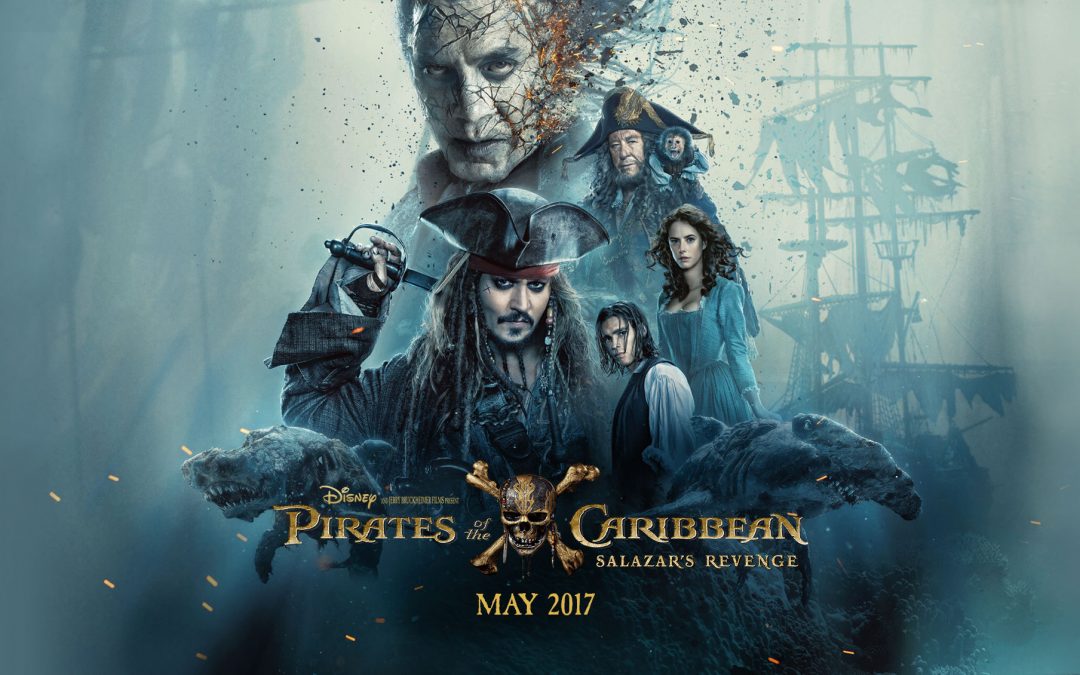 [Parent’s Content Advisory at bottom of review.]
[Parent’s Content Advisory at bottom of review.]
Note: After reading his review of “Pirates of the Caribbean: Dead Men Tell No Tales,” the author invites you to learn more about “Shadowlands and Songs of Light: An Epic Journey into Joy and Healing,” a new book that compares the writings of C. S. Lewis with the music of U2 in a life-changing journey through grief, joy, and longing for God. Available on Amazon and wherever books are sold.
Disney has brought out one of its sparkling golden cinema coins from the throwback days of the 2000s. (It’s not really that long ago but it feels like ages.) We live in a deeply nostalgic cultural moment–everyone feels something strong about the Golden Age of the good ol’ days–and bringing back “Pirates” is a powerful appeal to that emotion, especially if you loved the originals.
On a deeper level, the new film brings some in-the-background themes worth exploring, particularly some strong family themes that highlight the “treasure,” to quote Capt. Barbossa of family (if you can imagine a pirate saying that). This doesn’t mean the film is an all-ages family-friendly outing. It still has the usual mix of grimy PG-13 violence, fluttery-chested women being oggled, innuendo, and occultic overtones that characterize the Pirates series. You can read a full parent advisory at the bottom.
(Observations) Entertainment Value and Film Craft
I’m an easy target for Disney when it comes to these Pirates films. I have always loved the mystery of the sea, the old sailor myths, the magic of ships and dark nights at sea with the stars shimmering overhead as sailors chart their courses, and the adventure of it all.
In truth, life at sea in those days was grueling and always pushing human endurance to its limit.
But that’s the fun of the “Pirates” series. It breezily overlooks the realism of the actual sea life and dives into the myth and mystery of old sea tales with childlike glee. That’s what I loved about the first and second installments. “Dead Man’s Chest” is still my all-time favorite pirate movie. (And for that reason I still cannot forgive the writers for “At World’s End,” which completely ruined one of the greatest villains ever filmed, Davey Jones, for the sake of an over-complex, over-blown plot.)
“On Stranger Tides” was a decent return to a straight forward sea adventure, and it had some interesting religious themes.
“Dead Men Tell No Tales,” however, though suffering from over-complexity in the first two acts (and a heavy reliance on placing painfully obvious “I’m having this character say this to explain the next clue of the plot” exposition in dialogue), redeems itself with the stupendous third act and gives the audience such a satisfying Hollywood ending that the film comes close to recapturing the magic of “The Curse of the Black Pearl” and “Dead Man’s Chest.”
Plus, we get to see how Jack Sparrow got his nickname in a scene that I found rather charming and fun.
(Interpretation) Worldviews, Deeper Layers of Meaning, Edifying Themes
The film has some moving subtext about the treasure of family and the joy of being a father. There’s an admiration and respect for fatherhood in general–i.e. fathers are really valuable to our lives and to society–that is refreshing to find in a Hollywood film. (It’s a film you’d expect to be released on Father’s Day, actually, and I’m surprised they didn’t do that for marketing purposes. Though the fatherhood theme isn’t immediately obvious.)
You could also make a slight argument that the film works (unintentionally) as a soft critique of Scientism (the belief that science is the supreme arbiter of truth). We see the film begin with a female scientist named Carina–something unheard of in that era, it seems–and at first it has the typical scenario in which ignorant simple folk call her a witch because of her advanced knowledge of science, and she shrugs them off with disdain, even arrogance–as you might see some scientists do toward religious/supernaturally-inclined people today. But then the tables turn as her rigid intellectual dependence on naturalism prevents her from believing in anything supernatural or mythical.
This causes her great trepidation when the plot thickens and rather un-scientific things begin happening.
Indeed, she is beset by ghouls and ghosts and curses and monsters, and suddenly her know-it-all elitist approach to science is humbled. Her encounter with Salazar and other supernatural situations forces this change, and she realizes that science doesn’t have the answer to everything. To the character’s credit, she adapts very quickly and accepts the true nature of the enchanted world around her.
All that being said, the film carries on the series’ tradition of highlighting, with a bright spotlight at times, dark occultic elements. One of the heroes is accused of being a witch, but one of the other characters is an actual witch, and we see a couple scenes of her conducting or speaking about occultic rituals. That element has been my least favorite ingredient in the pirates series. It doesn’t feel true to the pirate world, at least not the Disney pirate world with is whimsical ambience of the Blue Lagoon Restaurant and the light-hearted Pirates ride. The dark occultic stuff feels out of place and dampening to the mood.
Conclusion: We Should’ve Gone from ‘Dead Man’s Chest’ Straight to ‘Dead Men Tell No Tales’
“Dead Men Tell No Tales” breathes some refreshing, welcome life into the Pirates series and is, in my opinion, the best and by far the most satisfying sequel, as far as storyline and plot development, since “Dead Man’s Chest.” In fact, I think I’d rather skip “At World’s End” and “On Stranger Tides” and just go straight to “Dead Men Tell No Tales” (sans occultic themes and other innuendo–if I were able to remake it exactly as I wanted it) in the “Pirates” series.
***
Want to read more reviews like this one? Sign up for our email alerts and get notified when we post a new review.
Content advisory for this PG-13 film…
Sexual Content/Nudity/Themes of Sexuality: Most of the sexual content is in the dialogue, though Carina wears a cleavage-bearing dress for the entire duration of the film. The pirates make several jokes filled with sexual innuendo. When Carina says she is a horologist, the pirates misunderstand and an running joke about the pirates being accepting of her profession as a prostitute continues throughout the film. A pirate jokes about another pirate’s mother and implies he slept with her.
Violence/Gore/Scary/Disturbing Content: The most gruesome moments of the film are when Jack looks in a basket and see severed heads from the guillotine and when we see the half-decomposed bodies of Salazar and his undead crew. The rest of the film’s violence comes from the usual PG-13 level of pirates shooting, impaling with swords, drowning, punching, and blowing up with cannons.
Language: Use of “G-d’s name” and “p-ss” off, as well as the British swear word “bugger.”
Alcohol/Drug/Smoking Content: Lots of rum. Mostly from Jack Sparrow.
Note: The parental guidance content advisory is written from a Christian worldview. I am a person of faith with orthodox Christian beliefs like those expressed in “The Everlasting Man” by G. K. Chesterton, “Mere Christianity” by C. S. Lewis, and “The Pursuit of God” by A. W. Tozer. That being said, I do not believe that the depiction of evil, even graphic depictions of evil or negative themes in films, is in itself always immoral. I believe it depends on the context and the worldview behind the film’s depiction of evil. All that being said, I try to report the content that gives the film its rating so that you can make an informed decision about viewing the film. Some people need to know detailed information about the content, some do not, in order to make a decision. I try to provide enough detail to give you a sense of the nature of the content. If you need more detail to make a better decision, I recommend visiting PluggedIn.com, as they provide extremely detailed reports of a movie’s content.


